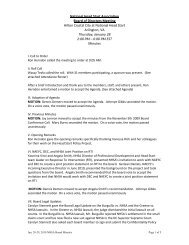New! - National Head Start Association
New! - National Head Start Association
New! - National Head Start Association
You also want an ePaper? Increase the reach of your titles
YUMPU automatically turns print PDFs into web optimized ePapers that Google loves.
Nourishing Nourishing Young Young<br />
Minds Minds and Bodies Bodies<br />
thank you or no, thank you. (Quick<br />
tip: Keep a towel tucked in your pocket<br />
during every meal for quick clean-up<br />
when spills do occur. By being prepared,<br />
messes will be less stressful and cause<br />
less of an interruption or distraction.)<br />
• Walk the walk: Model healthy habits<br />
by consuming nutritious foods with the<br />
children. Young children are amazingly<br />
observant, and although this strategy<br />
might not seem to work right away, it<br />
will help shape their attitudes and habits<br />
in the long-run. Ideally, teachers should<br />
eat the same foods that’s made available<br />
Fun snack and meal activities<br />
Kabobs<br />
What you need:<br />
1. Sliced soft fruit (strawberries,<br />
grapes, bananas, blueberries,<br />
melon)<br />
2. Cheese cubes (mozzarella and<br />
cheddar)<br />
3. Blunt toothpicks<br />
4. Bowl for each child<br />
Let children slide three or four pieces<br />
of fruit and cheese in any combination<br />
they choose onto toothpicks. Watch<br />
the delight of your little chefs as they<br />
assemble and eat their own tasty<br />
creations.<br />
Do you have an idea for a future nutrition topic? Is there a<br />
particular issue pertaining to nutrition that you would like to<br />
learn more about? If so, please e-mail your suggestions to<br />
jbrosnahan@rippelifestyle.com.<br />
to the children for snacks and lunch. If<br />
that is not possible, however, they are<br />
encouraged to at least include a piece of<br />
fruit or vegetable with their own lunch<br />
and milk or water to drink.<br />
• Perfect timing: Schedule enough time<br />
between snacks and meals (about two to<br />
three hours) to allow children to work up<br />
an appetite. But also keep in mind that<br />
young children will still eat less on some<br />
days and more on others. Remember that<br />
appetites usually coincide with growth<br />
patterns, which tend to slow down a bit<br />
during the preschool years.<br />
Mini Pizzas<br />
What you need:<br />
1. English mu ns<br />
2. Pizza sauce<br />
3. Grated part-skim mozzarella cheese<br />
4. Turkey pepperoni<br />
5. Chopped and sliced green pepper<br />
6. Large cookie sheet<br />
7. Paper plates<br />
Toast the English mu ns. Place toasted<br />
“pizza crusts” on paper plate and let the<br />
children top them with the toppings of<br />
their choice. Then broil the mini pizzas<br />
in the oven on a large cookie sheet until<br />
the cheese is melted. Cool for ve minutes.<br />
Have the children rewash hands<br />
and help set table while the pizzas cook<br />
and cool.<br />
• Respect children’s satiety signals.<br />
Research reveals that as long as regular<br />
meals and snacks are provided each day,<br />
small children are born with the ability<br />
to know how much to eat to grow into<br />
the body that is right for them. is<br />
natural ability to sense when they’ve<br />
eaten enough food is undermined when<br />
a caregiver or teacher regularly pressures<br />
a child to eat more or less than the child<br />
wants to. e risk of weight problems<br />
and eating disorders may increase<br />
as a result. Respond appropriately to<br />
children’s internal cues by allowing them<br />
to decide how much to eat from the food<br />
that is made available. Examples of outside<br />
pressures include persuading children<br />
to eat ve more bites or withholding<br />
dessert until they nish their vegetables.<br />
• Try, try again — but don’t pressure:<br />
Most children are naturally reluctant to<br />
try new foods. While many programs<br />
o er a healthy variety of good-tasting<br />
fare, children may grow up eating different<br />
cuisine at home. Children should<br />
be encouraged to eat at least one bite,<br />
but if they continue to decline, respect<br />
their decision and be patient. It’s normal<br />
for children to be cautious, and it may<br />
take at least 10 exposures before they are<br />
ready to even try a new food.<br />
• Keep it simple: Refrain from referring<br />
to foods as either good or bad, and<br />
avoid nutrition rules such as “you must<br />
eat three vegetable servings each day.”<br />
10 CHILDREN AND FAMILIES Back-to-School 2008<br />
THE MAGAZINE OF THE NATIONAL HEAD START ASSOCIATION




